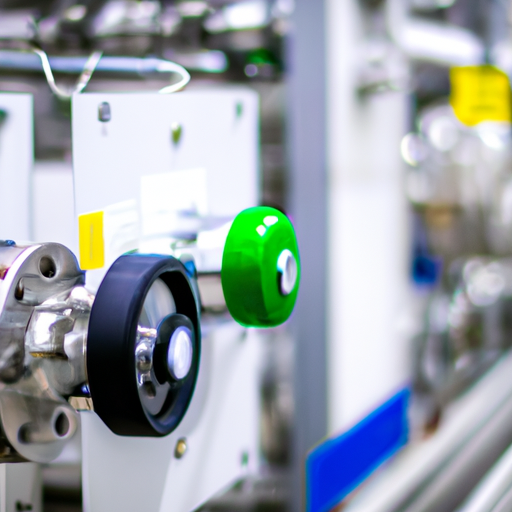Title: Industrial Automation and Control: Revolutionizing Manufacturing Processes

1. Programmable Logic Controllers (PLCs) (200 words) One of the key components of industrial automation and control systems is the Programmable Logic Controller (PLC). PLCs are ruggedized computers that monitor and control machinery and processes in real-time. They offer a wide range of features, including high-speed processing, multiple input/output (I/O) capabilities, and robust communication protocols. PLCs are highly flexible and can be easily programmed to perform complex tasks, making them ideal for automating various manufacturing processes.
2. Human-Machine Interface (HMI) (200 words) The Human-Machine Interface (HMI) is another crucial feature of industrial automation and control systems. HMIs provide a user-friendly interface that allows operators to interact with the automation system. They offer intuitive graphical displays, touchscreens, and control panels, enabling operators to monitor and control machinery, access real-time data, and make informed decisions. HMIs also facilitate remote monitoring and troubleshooting, enhancing operational efficiency and reducing downtime.
3. Supervisory Control and Data Acquisition (SCADA) (200 words) Supervisory Control and Data Acquisition (SCADA) systems play a vital role in industrial automation and control. SCADA systems enable centralized monitoring and control of multiple processes or facilities. They collect real-time data from various sensors and devices, analyze it, and provide operators with valuable insights. SCADA systems offer features such as data logging, alarming, and historical data analysis, enabling businesses to optimize their operations, detect anomalies, and improve overall productivity.
4. Industrial Robots (250 words) Industrial robots are a game-changer in the manufacturing industry. These automated machines are designed to perform repetitive tasks with precision and speed, reducing human error and increasing production efficiency. Industrial robots come with various features, including advanced sensors, vision systems, and adaptive control algorithms, allowing them to handle complex tasks and adapt to changing environments. They can be programmed to perform tasks such as assembly, welding, material handling, and quality inspection, freeing up human workers for more skilled and creative roles.
5. Machine Vision Systems (200 words) Machine vision systems are an integral part of industrial automation and control, particularly in quality control and inspection processes. These systems use cameras and image processing algorithms to capture and analyze visual data, ensuring product quality and consistency. Machine vision systems can detect defects, measure dimensions, read barcodes, and perform other critical inspections with high accuracy and speed. They enable businesses to automate inspection processes, reduce human error, and improve overall product quality.
Conclusion (100 words) Industrial automation and control systems have transformed the manufacturing industry, offering a wide range of product features that enhance productivity, efficiency, and quality. Programmable Logic Controllers (PLCs), Human-Machine Interfaces (HMIs), Supervisory Control and Data Acquisition (SCADA) systems, industrial robots, and machine vision systems are just a few examples of the remarkable technologies that have revolutionized manufacturing processes. As businesses continue to embrace automation, these product features will play an increasingly significant role in shaping the future of manufacturing, driving innovation, and enabling businesses to stay competitive in a rapidly evolving global market.
Title: Industrial Automation and Control: Revolutionizing Manufacturing Processes

1. Programmable Logic Controllers (PLCs) (200 words) One of the key components of industrial automation and control systems is the Programmable Logic Controller (PLC). PLCs are ruggedized computers that monitor and control machinery and processes in real-time. They offer a wide range of features, including high-speed processing, multiple input/output (I/O) capabilities, and robust communication protocols. PLCs are highly flexible and can be easily programmed to perform complex tasks, making them ideal for automating various manufacturing processes.
2. Human-Machine Interface (HMI) (200 words) The Human-Machine Interface (HMI) is another crucial feature of industrial automation and control systems. HMIs provide a user-friendly interface that allows operators to interact with the automation system. They offer intuitive graphical displays, touchscreens, and control panels, enabling operators to monitor and control machinery, access real-time data, and make informed decisions. HMIs also facilitate remote monitoring and troubleshooting, enhancing operational efficiency and reducing downtime.
3. Supervisory Control and Data Acquisition (SCADA) (200 words) Supervisory Control and Data Acquisition (SCADA) systems play a vital role in industrial automation and control. SCADA systems enable centralized monitoring and control of multiple processes or facilities. They collect real-time data from various sensors and devices, analyze it, and provide operators with valuable insights. SCADA systems offer features such as data logging, alarming, and historical data analysis, enabling businesses to optimize their operations, detect anomalies, and improve overall productivity.
4. Industrial Robots (250 words) Industrial robots are a game-changer in the manufacturing industry. These automated machines are designed to perform repetitive tasks with precision and speed, reducing human error and increasing production efficiency. Industrial robots come with various features, including advanced sensors, vision systems, and adaptive control algorithms, allowing them to handle complex tasks and adapt to changing environments. They can be programmed to perform tasks such as assembly, welding, material handling, and quality inspection, freeing up human workers for more skilled and creative roles.
5. Machine Vision Systems (200 words) Machine vision systems are an integral part of industrial automation and control, particularly in quality control and inspection processes. These systems use cameras and image processing algorithms to capture and analyze visual data, ensuring product quality and consistency. Machine vision systems can detect defects, measure dimensions, read barcodes, and perform other critical inspections with high accuracy and speed. They enable businesses to automate inspection processes, reduce human error, and improve overall product quality.
Conclusion (100 words) Industrial automation and control systems have transformed the manufacturing industry, offering a wide range of product features that enhance productivity, efficiency, and quality. Programmable Logic Controllers (PLCs), Human-Machine Interfaces (HMIs), Supervisory Control and Data Acquisition (SCADA) systems, industrial robots, and machine vision systems are just a few examples of the remarkable technologies that have revolutionized manufacturing processes. As businesses continue to embrace automation, these product features will play an increasingly significant role in shaping the future of manufacturing, driving innovation, and enabling businesses to stay competitive in a rapidly evolving global market.